6172RB Science a STEM approach Year 2 low res watermark
Create successful ePaper yourself
Turn your PDF publications into a flip-book with our unique Google optimized e-Paper software.
Biological sciences<br />
GROWING AND CHANGING<br />
Lesson 6<br />
Teacher notes<br />
<strong>Science</strong> inquiry focus:<br />
How do offspring of insects grow and change?<br />
<strong>Science</strong> Inquiry Skills:<br />
• Questioning and predicting QP<br />
• Planning and conducting PC<br />
• Processing and analysing data and information PA<br />
• Evaluating E<br />
• Communicating C<br />
<strong>Science</strong> as a Human Endeavour:<br />
• Students act like scientists when they make observations<br />
and describe the growth of insects.<br />
• Students explore how science is used to identify the stages<br />
that animals have in common as they grow and change.<br />
Technology/Engineering/Mathematics links:<br />
• using a digital device to take a photograph<br />
• identifying a predictable pattern in the stages of insects, and<br />
using it to sort insect images correctly<br />
Background information<br />
• Most insects completely change their size, shape and<br />
colour during a life cycle of four stages from egg, larva,<br />
pupa to adult. This is called complete metamorphosis.<br />
These insects include butterflies, moths, flies, ants, bees,<br />
beetles and ladybugs.<br />
• Some insects, such as grasshoppers and cockroaches,<br />
have three stages—egg, nymph (larva) and adult. The<br />
larva looks similar to the adult, so it is called incomplete<br />
metamorphosis.<br />
• Other insects, like silverfish and lice, have no<br />
metamorphosis. They hatch from eggs looking like<br />
miniature adults and grow larger over time.<br />
• This lesson is to highlight that some living things do not<br />
look the same as an offspring as they do as an adult. They<br />
do, however, have predictable stages of development<br />
and observable changes. It is not meant to go too in<br />
depth into life cycles as this is covered in <strong>Year</strong> 4.<br />
Assessment focus:<br />
• Use page 26 as a formative<br />
assessment of the student’s<br />
understanding that insects go<br />
through common changes and<br />
do not look the same at birth<br />
through top adulthood.<br />
• Page 26 can also be used as a<br />
summative assessment when<br />
they compare the changes of<br />
all animals and how they are<br />
different or the same.<br />
Resources<br />
• A bug’s life video clip<br />
<br />
• Strips of blank paper<br />
• Print, copy and laminate<br />
images on pages 23–25,<br />
1 per station<br />
• iPad® or digital camera<br />
• Sufficient copies of page 26<br />
for students<br />
• Short episode from<br />
Miniscule linked to QR<br />
code on page 26 <br />
© R.I.C. Publications<br />
Low <strong>res</strong>olution display copy<br />
R.I.C. Publications® – www.ricpublications.com.au 978-1-925431-95-7 YEAR <strong>Science</strong>:<br />
2 A <strong>STEM</strong> APPROACH 21


















